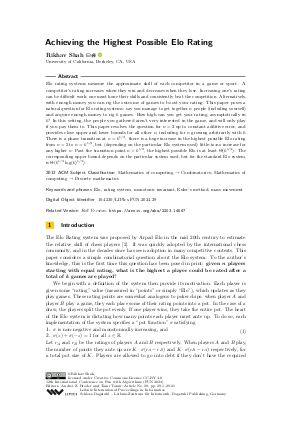Achieving the Highest Possible Elo Rating
Author
Rikhav Shah 
-
Part of:
Volume:
12th International Conference on Fun with Algorithms (FUN 2024)
Part of: Series: Leibniz International Proceedings in Informatics (LIPIcs)
Part of: Conference: International Conference on Fun with Algorithms (FUN) - License:
 Creative Commons Attribution 4.0 International license
Creative Commons Attribution 4.0 International license
- Publication Date: 2024-05-29
File

PDF
LIPIcs.FUN.2024.29.pdf
- Filesize: 0.76 MB
- 21 pages
Document Identifiers
Related Versions
- Full Version https://arxiv.org/abs/2203.14567
Subject Classification
ACM Subject Classification
- Mathematics of computing → Combinatorics
- Mathematics of computing → Discrete mathematics
Keywords
- Elo
- rating system
- monotonic invariant
- Euler’s method
- mass movement
Metrics
- Access Statistics
-
Total Accesses (updated on a weekly basis)
0PDF Downloads0Metadata Views
Abstract
Elo rating systems measure the approximate skill of each competitor in a game or sport. A competitor’s rating increases when they win and decreases when they lose. Increasing one’s rating can be difficult work; one must hone their skills and consistently beat the competition. Alternatively, with enough money you can rig the outcome of games to boost your rating. This paper poses a natural question for Elo rating systems: say you manage to get together n people (including yourself) and acquire enough money to rig k games. How high can you get your rating, asymptotically in k? In this setting, the people you gathered aren't very interested in the game, and will only play if you pay them to. This paper resolves the question for n = 2 up to constant additive error, and provides close upper and lower bounds for all other n, including for n growing arbitrarily with k. There is a phase transition at n = k^{1/3}: there is a huge increase in the highest possible Elo rating from n = 2 to n = k^{1/3}, but (depending on the particular Elo system used) little-to-no increase for any higher n. Past the transition point n > k^{1/3}, the highest possible Elo is at least Θ(k^{1/3}). The corresponding upper bound depends on the particular system used, but for the standard Elo system, is Θ(k^{1/3}log(k)^{1/3}).
Cite As Get BibTex
Rikhav Shah. Achieving the Highest Possible Elo Rating. In 12th International Conference on Fun with Algorithms (FUN 2024). Leibniz International Proceedings in Informatics (LIPIcs), Volume 291, pp. 29:1-29:21, Schloss Dagstuhl – Leibniz-Zentrum für Informatik (2024)
https://doi.org/10.4230/LIPIcs.FUN.2024.29
BibTex
@InProceedings{shah:LIPIcs.FUN.2024.29,
author = {Shah, Rikhav},
title = {{Achieving the Highest Possible Elo Rating}},
booktitle = {12th International Conference on Fun with Algorithms (FUN 2024)},
pages = {29:1--29:21},
series = {Leibniz International Proceedings in Informatics (LIPIcs)},
ISBN = {978-3-95977-314-0},
ISSN = {1868-8969},
year = {2024},
volume = {291},
editor = {Broder, Andrei Z. and Tamir, Tami},
publisher = {Schloss Dagstuhl -- Leibniz-Zentrum f{\"u}r Informatik},
address = {Dagstuhl, Germany},
URL = {https://drops.dagstuhl.de/entities/document/10.4230/LIPIcs.FUN.2024.29},
URN = {urn:nbn:de:0030-drops-199376},
doi = {10.4230/LIPIcs.FUN.2024.29},
annote = {Keywords: Elo, rating system, monotonic invariant, Euler’s method, mass movement}
}
Author Details
References
-
Arpad E. Elo. The proposed USCF rating system: Its development, theory, and applications. Chess Life, 23(8), August 1967.

-
Arpad E. Elo. The Rating of Chess Players, Past and Present. Arco Publishing, second edition, 1978.

- FIDE. FIDE Ratings and Statistics. URL: https://ratings.fide.com/.
- FIDE. FIDE Handbook. https://handbook.fide.com/, 2017.
- Mike Paterson, Yuval Peres, Mikkel Thorup, Peter Winkler, and Uri Zwick. Maximum overhang. The American Mathematical Monthly, 116(9):763-787, 2009. URL: https://doi.org/10.4169/000298909X474855.
-
Jeff Sonas. The Elo rating system – correcting the expectancy tables. ChessBase, March 2011.

